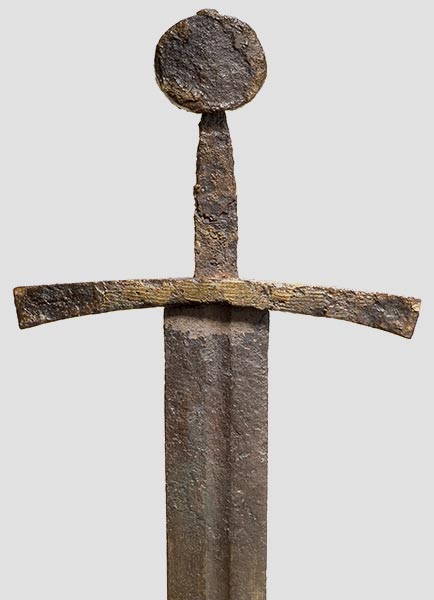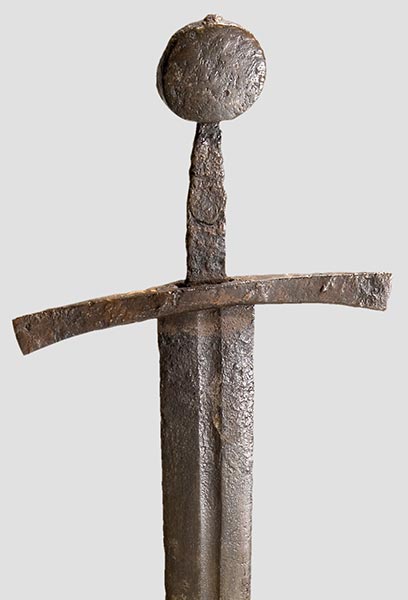Greetings! I am new to this web site ... and love it! I have finally begun a medieval sword collection with my first acquisition. My question to you all is: Do you know (or are you) an expert conservator of ancient swords either here in the USA or in Europe that I could consult with some questions regarding possibly cleaning my sword? It is in relatively very good shape for its age (13th century) but has some rust and brown patina. Sometime in the past the blade was covered with clear laquer, which I believe did help conserve the sword. However, I wonder if it would be wise to get the laquer off and potentially clean the entire sword either chemically or via electrolysis. Is anyone an expert in this or do you know which American museum has an expert on staff that I could consult?
Many Thanks!
My suggestion would be to remove the varnish, or whatever is coating your sword. One of my medieval swords was coated in a varnish type substance and I noticed that it was still rusting under the coating. Areas of the surface were blistering due to trapped moisture. I stripped the sword of all coatings and then soaked the entire sword in WD-40. I let it set for a few minutes and used a dental pick to remove any loose rust. It took several coatings to loosen all the rust. As I went about doing this task, I was surprised to see how many of these flakes had active rust underneath them. I avoid using steel wool, sandpaper, or other abrasive items. Instead, I used a cloth and a toothbrush to remove all surface rust. This takes longer but you get a better result. When I was done I chose not to coat it with any protective covering. If you would like to coat the sword, I understand that beeswax is a safe alternative. I'm sure there are other methods, this is just what I did for mine.
Just remember, when it comes to conserving excavated swords, less is more!!!
Good Luck!
Just remember, when it comes to conserving excavated swords, less is more!!!
Good Luck!
Remember that a controlled degree of rusting is sometimes the best option, rather than trying to clean it and ending up leaving it vulnerable or in worse shape. I don't know if it's a very valuable item but if it's that old you might consider leaving it to the care of a professional. Your best bet is to contact a museum, most of them which are big enough sometimes offer restoration services to the public, or could at least point you in the good direction.
The British Museum and other collections use a product called Renaissance Wax to preserve the finnish on antique swords and other artifacts once they have been conserved. Check this link here
http://www.picreator.co.uk/articles/3_renaissance_wax.htm
http://www.picreator.co.uk/articles/3_renaissance_wax.htm
Do not use electrolysis or chemicals. It may attack the steel and destroy the sword's patina. The patina should NOT be removed (it is, just as the patina on a katana's nakago, a sign for age and authenticity). You can remove the rust with a dremel and a steel brush (no grinding wheel or something like that, just a brush). Sounds harsh, but it will neither attack the substance nor the patina and will remove the active rust. You can also use a bit of sandpaper, but be careful.
Peter
Peter
Jan,
If I were you I would contact the Arms and Armour dept. at the Metrpolitan Museum before I did anything! It is all to common for well meaning collectors to attempt to clean items like this , often with drastic and irreversable results. :cry:
They will, as has been pointed out, at least point you in the right direction. Do remember to send them pictures with your enquiry though.
Good luck.
Russ
If I were you I would contact the Arms and Armour dept. at the Metrpolitan Museum before I did anything! It is all to common for well meaning collectors to attempt to clean items like this , often with drastic and irreversable results. :cry:
They will, as has been pointed out, at least point you in the right direction. Do remember to send them pictures with your enquiry though.
Good luck.
Russ
You could post here as well some pictures :D A lot of people, including me would really appreciate it.
Thanks so much for all your input! Here are my thoughts - definitely consult an expert - I'll start at the Metropolitan Museum in NYC which has a super-impressive collection of armour and some swords that I have seen several times. If no luck, I'll try one or two others. I definitely want to get the lacquer layer off but want to preserve my sword's patina, my only mention of electrolysis was because I have seen it mentioned on one or two swords in E. Oakenshott's books and considering the relatively good shape of this sword I thought it could be an option. Will consult the experts, though.
About the sword: got it at a German auction after closely following major arms auctions for about 2 years. Having some insight into its provenance, I believe it is genuine. It was likely not excavated (e.g. river-found) but rather was taken from a cript. This accounts for much more corrosion on one side (the side facing the deceased's body) than the other. As per one of your requests, I am enclosing some photos. The pics do not show the lacquer covering very well but in the details, notice the lighter "band" under the cross quard - the band has no varnish (and much more rust), possibly a remnant of how the sword was mounted for display in the past .
If my museum connections don't pan out or if they agree with the WD-40/bees wax (or special UK wax) cleaning-preserving suggestion one of you presented, I will do just that. I am wiling to pay for professional conservation but the suggested procedure makes a lot of sense. My main fear is in removing the lacquer...
Thanks again to all!
 Attachment: 26.9 KB
Attachment: 26.9 KB

 Attachment: 23.77 KB
Attachment: 23.77 KB

 Attachment: 7.98 KB
Attachment: 7.98 KB

About the sword: got it at a German auction after closely following major arms auctions for about 2 years. Having some insight into its provenance, I believe it is genuine. It was likely not excavated (e.g. river-found) but rather was taken from a cript. This accounts for much more corrosion on one side (the side facing the deceased's body) than the other. As per one of your requests, I am enclosing some photos. The pics do not show the lacquer covering very well but in the details, notice the lighter "band" under the cross quard - the band has no varnish (and much more rust), possibly a remnant of how the sword was mounted for display in the past .
If my museum connections don't pan out or if they agree with the WD-40/bees wax (or special UK wax) cleaning-preserving suggestion one of you presented, I will do just that. I am wiling to pay for professional conservation but the suggested procedure makes a lot of sense. My main fear is in removing the lacquer...
Thanks again to all!



I remember the sword, you made a good purchase. It looks like most of the sword is in great shape. You should be able to treat the sword yourself but if your confidence level is low, it would be best to consult an expert.
Congratulations!
Congratulations!
For storage you could put it in a plastic crate filled with silica gel, which will absorb moisture.
That little envelopes containing small grains that would make a dry noise when touched, they were often found in the past in packages containing stereo and other electronic appliances.
That little envelopes containing small grains that would make a dry noise when touched, they were often found in the past in packages containing stereo and other electronic appliances.
Page 1 of 1
You cannot post new topics in this forumYou cannot reply to topics in this forum
You cannot edit your posts in this forum
You cannot delete your posts in this forum
You cannot vote in polls in this forum
You cannot attach files in this forum
You can download files in this forum
All contents © Copyright 2003-2006 myArmoury.com — All rights reserved
Discussion forums powered by phpBB © The phpBB Group
Switch to the Full-featured Version of the forum
Discussion forums powered by phpBB © The phpBB Group
Switch to the Full-featured Version of the forum